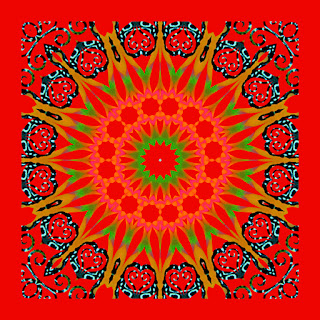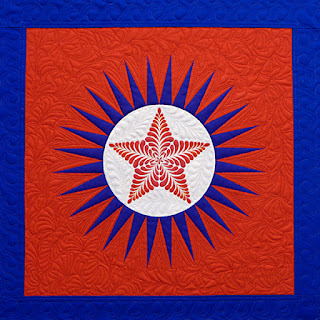I'm lucky to write a column called Filler Finesse for Machine Quilting Unlimited. Each issue I show how to quilt three filler designs, including a written description, diagrams, and stitch outs of each filler. I also create a composition where I use all three fillers. In every issue I try to make the composition a little different. The first three issues of this year I made pictorial compositions (see an example here), but I wanted to switch things up a little for the next three. Here's the example from the July/August issue:
When I first started quilting the part I loved the most was the piecing. I've pieced many a sharp point in my day, but honestly didn't want to do that for this design. OK, this may seem like cheating, but for this little wall hanging I decided to use a couple of different software programs to create the look I wanted. It was much faster than piecing!
First I used Electric Quilt to create the blue rays. Briefly, I modified the block "Dean's Sunflower Sun", found in the Contemporary Pieced, Sun Compasses library. I simplified the block so that it consisted only of the rays, and then used the block by itself in a quilt layout. Then I exported that image as a jpeg. I originally saved the "quilt" with black rays, and later changed the background to red and the rays to blue in Photoshop.
 |
| The compass as it appeared when exported out of Electric Quilt |
 |
| I used the magic wand tool in Photoshop to change the color of the rays and background |
I imported the feathered star into Photoshop and created a duplicate of the background layer. I used the magic wand tool to select and then clear the white background from the duplicate layer, leaving me with just the feathered star. I then dragged the star over the red, white, and blue compass.
I resized the star to fit the center circle, adjusted my colors a little, and voila, my cheater panel was complete! I printed it as large as I could (13"x13" on my printer), then added the blue borders. All of those solid colors provided a great canvas to show off my fillers.
Stay tuned for Part 3 of this series on ways I use Kaleidoscope Kreator in my work, where I'll show how I've used kaleidoscopes in digital collages for art quilts.












